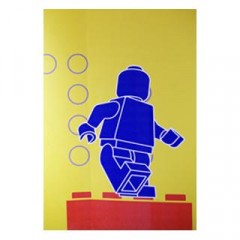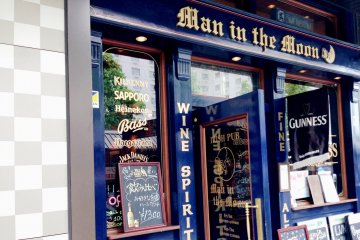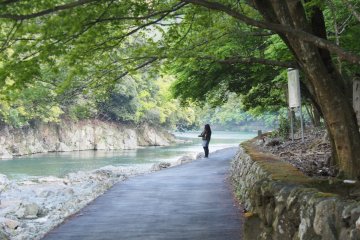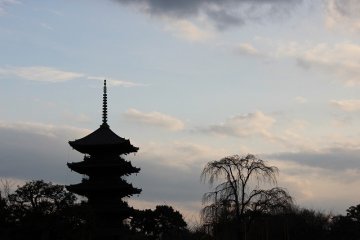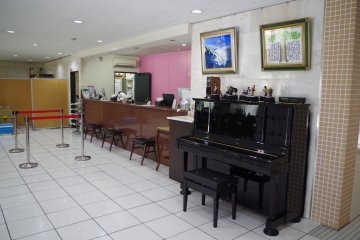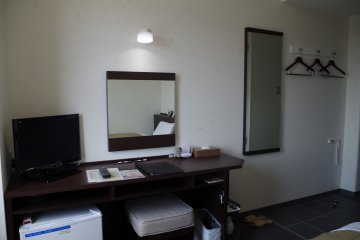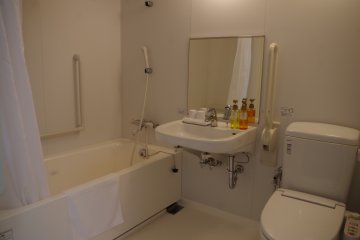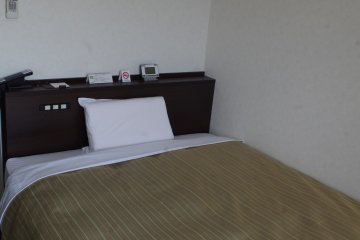Kyoto Plaza Hotel is an economical choice for single travelers on a mid-range budget and do not want to stay in a hostel to keep your privacy during your trip. Since it is more like a business hotel, it provides compact single, twin, and double rooms in Western style. The single rooms have a semi double bed about 140 cm wide, which is spacious for one person at 6800 yen. For two people, there is a choice between the semi double bed (11000 yen) or the double bed (13000 yen). The semi-double beds are a bit tight for two small adults, but for everyone else, the double bed is a better bet, or consider having 2 single rooms for ultimate privacy and freedom, as the cost of 2 single room is only 300 yen more than a double room, and you don’t need to fight over the TV remote or the bathroom. On the other hand the double rooms are spacious for this price range. If you are a light sleeper, or you are concerned with noises from your neighbor, ask for a room at the back of the building or the corner room, those ending with a number 3, 5, or 9. For example corner room 2103 would be on level 11, room 3. The simple layout, being clean and tidy, with white walls, beige and white striped or floral bed covers, suits all the basic needs you can have in a hotel.
Located just six minutes’ walk from the Hachijo Exit of JR Kyoto Station, past the Aeon Shopping Mall, Kyoto Plaza Hotel is conveniently located if you are coming to Kyoto late at night or leaving early in the morning, with the airport bus stop as well as the bullet train station being close by. It is also handy if you would like to go to Arishiyama or Kameoka by train, as well as day trips further afield to Nagoya, Osaka, Kobe and Himeji. If you are heading to Nara, it is only a three-minute walk from Kintetsu Toji Station. Kyoto's city bus and subway stations are also close by for sightseeing within Kyoto City. One tip you will appreciate is the local 202 or 207 bus from Kujo Street to Higashiyama. It bypasses the crowds at Kyoto Station and the traffic north of the tracks.
Guests coming by car will find easy access from the South Kyoto exit of the Meishin Motorway, and car parking (1,000 yen per day) is available on a first come first served basis.
Being a small business hotel, it does not have a function room but there is a lounge area on the ground floor. There are also internet computers for free, as well as a public telephone and a rack of travel brochures.
On the second floor there is a communal bath and the massage room. The bath is open from 5pm to 2am and massage from 3pm to 11pm on weekdays and Saturday, but closing earlier on 10pm Sundays. Guests also receive a voucher for a 15 minute neck massage, perfect for weary travelers.
The hotel offers free breakfast from 6:30 am to 9:30 am. It is in the cafeteria on the ground floor, which is only open in the morning. To suit customers from different countries, it has Japanese food like miso soup, soba and dried seaweed if you want to taste the local flavour; for western dishes, it provides coffee and tea with bread and salad. It is a simple and healthy way to start the day. The Shinme Japanese restaurant on the other hand offers lunch from 1050 yen and 1575 yen for dinner. Alternatively Kyoto Station has a variety of tourist friendly restaurants with English menus, such as the Aoi Soba Place, or Pontoiru for Japanese Italian Fusion Pasta.
On the top floor there is an observation deck with a panoramic view to the Toji Temple, founded in 796. Looking out over the roof lines of South Kyoto with Toji Temple towering with the mountains in the background, it reminded me of the view of Florence from the Duomo, albeit a Japanese version of a small city. While Kyoto north of the station is a mix of modern buildings, machiya lined alleyways and the ever present Kyoto Tower, the skyline to the south is more local and prosaic, a bit like what the city looked like a lifetime ago with remnants of family businesses in corrugated iron workshops and monochrome post war houses, like a Shitamachi of Kyoto. Here you will see the locals going about their day to day business, largely uninterrupted by tourists who throng the main attractions on the other side of the train tracks.


